A steed reborn: the Australian War Memorial’s restoration of OV-10A Bronco 67-14639
On 18 August 2023, Vietnam Veterans' Day, the Australian War Memorial unveiled a fully restored North American Rockwell OV-10A Bronco, model 639, which played a key role in the Vietnam War. The Memorial has been working on the front-line Bronco since it arrived from the Philippines, on HMAS Tobruk, in 2006.
An event was held at the Treloar Technology Centre, where the restoration project was carried out, to mark the occasion.
Identifying and recovering the aircraft
By Air Vice Marshal Graham Neil AO, DFC, DFC (US) Rtd
Prolonged and extensive efforts were made by many individuals over a number of years to obtain a USAF aircraft flown by RAAF Forward Air Controllers in Vietnam for display at the Australian War Memorial.The chain of events started with extensive research conducted by a volunteer at the AWM, Alan Storr (ex RAAF) who was tasked in March 1998 by John White, the Senior Curator Military Technology at the AWM, with contacting all RAAF FAC’s who had served in Vietnam, seeking log book details of all missions flown. The responses showed that in all, twenty RAAF FAC’s had flown 77 different OV-10’s. The tail numbers were listed in priority order but the first three had suffered combat losses. The fourth choice was 67-14639, which had been flown for a total 129 missions by eight RAAF FAC’s. Former FAC Ken Semmler shared the information with the OV-10 Bronco Association (OBA) at Fort Worth Texas, which then commenced an exhaustive world-wide search for each identified aircraft. The tail numbers were traced by researching documentation associated with the provision of spare parts to the various air forces flying OV-10’s.
In June 2001, 639 was detected as being in storage in the Philippines and in November that year contact was made through the OBA with Captain Silvestre Glinoga (“Big Mac”) who was a member of the Philippines chapter of the OBA. That discovery, complete with photographs provided by Big Mac, was to assist greatly in fostering support in Australia. The aircraft was indeed in storage at Sangley Point, Cavite City, within a few hundred metres of a large wharf previously used by the US Navy.
The first hurdle was gaining ownership of an American aircraft that had been provided to the Philippines Air Force (PAF) under their Foreign Military Finance (FMF) scheme, where the United States provided the finance for the Philippines to purchase the aircraft subject to US restrictions on disposal. Support was provided by numerous officers within the Australian Defence Department, as well as by serving RAAF officers and former FAC Doug Riding, who was a member of the AWM Council. Lobbying began in earnest with Doug Riding and I signing a letter to the AWM seeking their interest and support as well as gaining permission from the Defence Department to deal directly with successive Defence Attaches in Manila, initially Group Captain Greg Sutton, and subsequently Colonel Chris Burns. The Defence Attaches succeeded in arranging the transfer of 639 from the PAF via the Joint United States Military Advisory Group (JUSMAG) to the US State Department and to the RAAF FAC Association, subject to it being held by the Australian Government.
On 5 September 2003 the US Embassy in Canberra provided a diplomatic note regarding an end-user agreement on weaponry and use of 639. On 13 April 2004 Lt Col Dwight Kenyon, of the Joint US Military Advisory Command, confirmed the donation of the aircraft '…to the Forward Air Controller Association of Australia in cooperation with the Australian War Memorial.' That provided, we concentrated on transportation of 639 and its eventual home in Australia. Approaches were made to the RAAF and RAN and the AWM with the most encouraging transport support being from the RAN. The navy tasked HMAS Westralia to pick up 639 in October 2004 but the absence of adequate quarantine and stevedoring requirements at Sangley Point necessitated road or barge transportation to the Westralia in Manila. As it turned out that shore to ship move was never to be carried out because the Philippines Finance Department vetoed the transfer over a dispute over ownership of 639 at the last minute. But the team had learnt all the requirements for our next attempt.
The RAN forecast some difficulty in tasking another ship for a while so efforts were made to lobby CDF, the USN and the RNZN all to no avail despite their cooperative attitude. Back in the Philippines the new Defence Attache Manila Colonel Chris Burns completed the necessary ownership arrangements, following which the aircraft was formally handed over to Air Marshal Angus Houston at a formal parade on 21 Feb 2005 during his official visit to the Philippines.
In June 2006 HMAS Tobruk was tasked to pick up 639 but that task had to be cancelled because of Australia’s support to the Solomon Islands after a severe cyclone there. Our navy made another attempt to assist with joint visits by HMAS Darwin and HMAS Newcastle (each carrying one container) but that task was thwarted by typhoon Milyeno. The Philippine Defence Force was also fully tied up in post-typhoon tasking. Also, the ships had been provided only eight days’ notice whereas two weeks were needed for the disassembling and preparation of the aircraft.
We took a long hard look at the financial realities of civil shipping along with stevedoring and road transport costs and they were prohibitive for us. The AWM was kept apprised of all efforts and they too had examined what it would cost to have the aircraft prepared and transported to Manila; they budgeted $50,000 for the task. Additionally, an AWM technician, Lee Davies, was attached to Sangley Point to supervise the disassembly of the aircraft and its preparation to meet Australian quarantine requirements. The RAN came to the party once again (fourth attempt) and HMAS Tobruk successfully carried 639 to Sydney in March 2007 and the AWM transported her to their Mitchell Annex in Canberra by road transport.
The immediate following years provided more frustrations, although the AWM was about as keen as we were to start refurbishment they were severely hampered by the Government’s austerity program which prevented any recruitment by the AWM. During that lull our members were canvassed to provide additional log book and sortie details to Darrel Whitcomb (Nail 25) who carefully drafted a nine- page booklet covering the history of 639 in Vietnam, Thailand, Germany, USA, South Korea and the Philippines. In April 2008 the FAC Association held a very successful reunion, organised by Mac Cottrell, which included the dedication of a bronze plaque commemorating FAC service in Vietnam and the presentation of Darrell Whitcomb’s historical account to the AWM. The AWM completed a survey on the aircraft to assess its spares requirements. The AWM’s John White visited the USA for official museum-to-museum matters in January 2011 and managed to include a side trip to visit Jim Hodgson at the OBA. The search for current spare part providers continued with very knowledgeable assistance from Jim Hodgson, Chuck Burin and other OBA members and this was managed by Ken Semmler who had picked up many useful contacts during his visits to the USA.
In July 2013 Doug Riding and I had a very productive meeting with Dr Brendan Nelson, the Director of the AWM, with Tim Sullivan the Assistant Director, Branch Head National Collection and Rebecca Britt, Head Military Heraldry and Technology. During this period Ken Semmler spent a lot of time pursuing contacts with the DA Jakarta and the TNI-AU in our quest for spares.
In 2016 Dick Smith generously provided $50,000 to the AWM for aircraft conservation, which the Memorial allocated to the 639 refurbishment project. In May 2017 Laura Kennedy and Kim Wood visited likely sources of information regarding refurbishment with Tony De Bruyn who runs the Bronco demonstration team in Belgium and the OBA, CALFIRE and Marsh Aviation in the USA. All of these contacts had been refined over the years between the OBA and Ken Semmler.
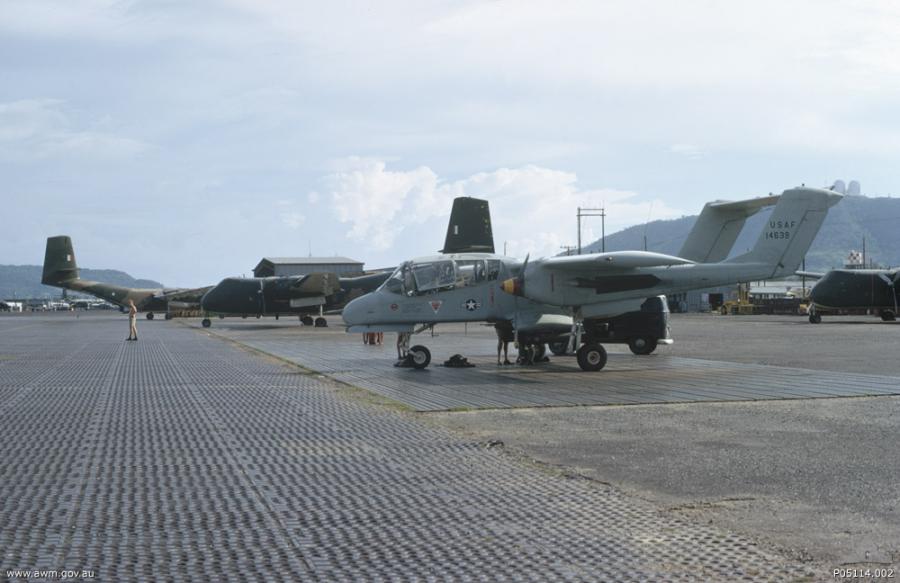
Bronco 67-14639 in Vietnam
Why is the aircraft worth saving?
The men who originally recognised the Bronco and struggled to get it brought back to Australia saw the aircraft as an item of great personal importance, holding exciting and poignant memories for them. But they also recognised Bronco 67-14639 as a significant part of the Australia’s aviation and military heritage. Although the aircraft never wore Australian livery and was never part of the country’s air force, a large number of Australians flew this type of aircraft in combat. At least seven Australians are known to have flown this particular aircraft in combat while attached to the USAF, participating in a conflict in which Australia was a major allied partner for nearly 10 years. Bronco 67-14639 serves as a representation of their service, as well as a tangible representation of the Australia–US alliance.
The aircraft is also of great technological significance: as an aircraft designed in the 1960s expressly for counter insurgency, it represents a milestone in the history of military aviation. The features which were engineered into the aircraft, and which made it such a success, were necessary for its operation in this type of asymmetrical conflict. The aircraft is also socially significant, being a tangible symbol of the role and importance of FACs during the war. Indeed, the aircraft could not have survived without the support of an active network of Australian veterans who flew Broncos (including this particular aircraft). The FAC network in Australia and the USA provided the Memorial with an invaluable photographic record, insights into the operation and configuration of aircraft, and facilitated international contacts in support of the restoration project. As well as providing an exhibition-ready artefact of air support capabilities in the Vietnam War, saving the Bronco will be of great value to Vietnam veteran groups.
The Bronco’s origin
Designed in the early 1960s, the North American Rockwell OV-10A Bronco was unlike anything then in the US inventory, both in appearance and performance. Majors Beckett and Rice, US Marine Corps officers who had served as forward air controllers in Korea, had seen the value of slow and low close air support for ground troops. They drew up an ambitious list of requirements for a light, short take-off and landing support aircraft, and doggedly pushed their concept to government and industry. By 1963, with a growing counterinsurgency operation in south-east Asia, sufficient support had been garnered for the US Defence Department to approach industry for detailed proposals. The aircraft was to be multipurpose, capable of carrying 2400lbs of ordnance, able to operate from small unprepared airstrips, able to maintain position over a target 50 miles from its base for one hour, capable of 350mph, operable from aircraft carriers, able to fly on one engine, and have a short 800-foot take-off run. Eleven companies submitted designs, with North American Aviation in Columbus, Ohio being the successful tenderer.
The Bronco prototype flew its first test flight as the YOV-10 on 16 July 1965, just nine months after the contract had been approved.
The Bronco’s characteristics
The aircraft featured a twin boomed design with its fuselage suspended under a high wing. It carried a two-man crew – pilot in the front position and an observer in a seat directly behind – in a cockpit with a large bulbous canopy, featuring a view of the ground unimpeded by the high wing. This allowed the crew to observe and acquire ground targets more easily than in other aircraft being used, such as the Cessna Bird-Dog and the Skymaster. The downside of the large canopy was that the cockpit heated up quickly, particularly in the tropics.
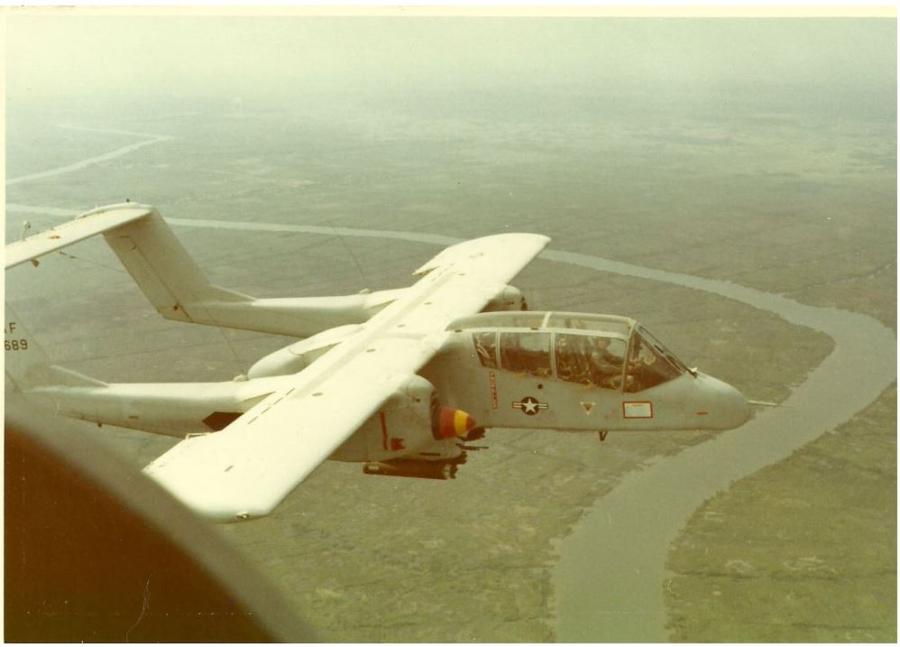
Bronco 67-14689 showing the large canopy
Recognising that much of the aircraft’s work would be conducted over hostile ground forces, the manufacturer provided self-sealing fuel tanks and cockpit armour plating to lessen the risk from ground fire. Both crew positions had ejection seats. The observer could initiate his own seat, while the pilot could eject both himself and the observer, with a short time delay ensuring that the observer ejected first. Behind the cockpit was a large cargo area of 110 cubic feet, capable of carrying 3,200 pounds of cargo as well as five paratroopers, or two wounded troops on stretchers with their medic.
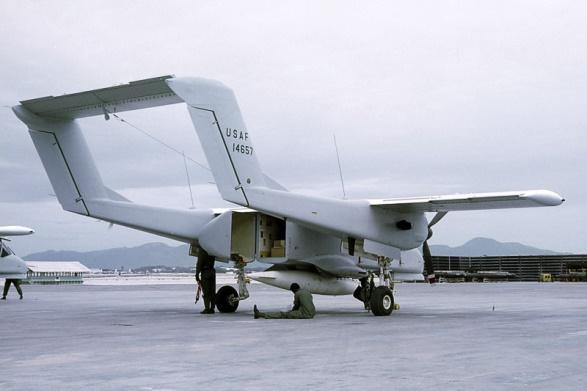
The Bronco’s cargo area was enclosed by a large fibreglass hinged cone
Power was provided by two Garret AiResearch T76-G-410/412 turboprop engines, each of which provided 715 shp. The engines turned in opposite directions in order to counteract torque, and were carried in booms suspended below the wing, which gave good access for maintenance crews. Although the original specifications called for a 20’ wingspan to allow the aircraft to land in remote rural areas and on roads, the prototype was given a 30’ wingspan, which was enlarged to 40’ in the production model.
The aircraft was armed with four M60C belt-fed machine-guns, with 500 rounds per gun. The guns were fitted in two downward angled sponsons carried on either side of the main fuselage. Four external hard points on the sponsons could carry 500-pound bombs, 5-inch Zuni rocket launchers, or 2.75-inch rocket pods, while a centreline hard-point could carry a 1,000 pound bomb or a 230 gallon external fuel tank. Two wing stations could carry rocket pods, fuel tanks, or AIM 9B sidewinder air-to-air missiles. A key feature of the Bronco was its communications capability: a VHF set to communicate with other FAC and headquarters, a UHF set to coordinate fighter strikes, two FM sets to speak with ground units and artillery batteries, and an HF set for communication with FAC headquarters when VHF was not possible. The aircraft could be configured for strike reconnaissance, forward air control, or light logistics transport missions.
The Bronco in Vietnam
Production of the Bronco was ordered in 1966, and the initial flight of the production variant (OV 10A) took place in August 1967. The aircraft was quickly made available for operational flights, with the first combat mission being flown by the Marine Corps’ VMO-2 on 6 July 1968 near Danang. US Air Force Broncos began operating in August 1968 out of Bien Hoa near Saigon. An additional Marine Bronco Squadron VMO-6 began operating out of Quang Tri in November 1968.
Although the USMC embraced the use of Broncos, the USAF was more tentative in its acceptance of the aircraft, with the first deliveries of aircraft being evaluated under a Combat Bronco program. These Broncos were initially unarmed. It was only after 5 June 1969 that the Air Force Broncos were authorised to carry machine-guns in the side sponsons and to fit rocket pods. Prior to that time, photographs show that the openings in the sponsons were faired over.
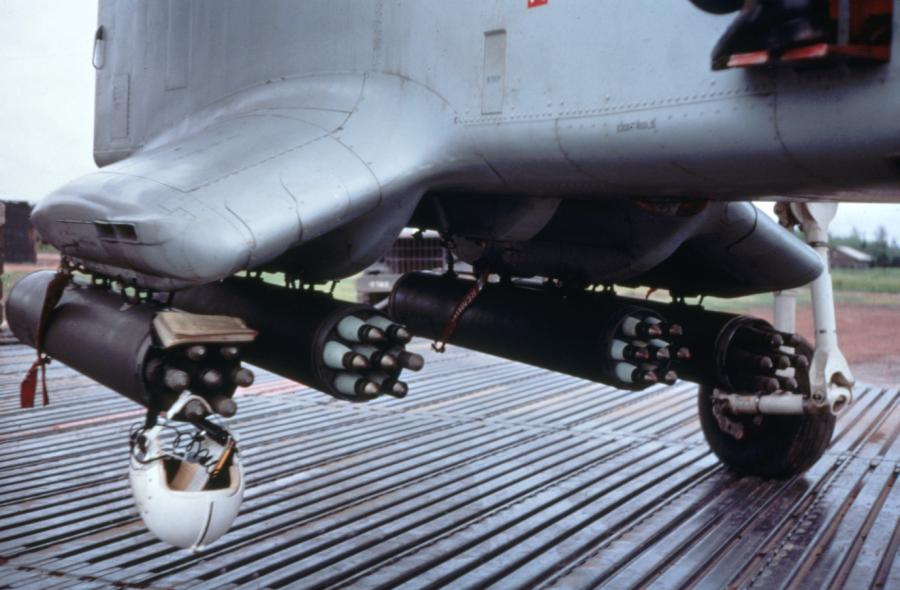
A Bronco with underbody rockets, but still with the machine-gun positions faired over
The Australian War Memorial’s Bronco
The Memorial’s OV-10A, serial number 67-14639, was built in Ohio in 1968 – the 101st of 271 aircraft built for US and allied service. Accepted by the USAF in August 1968 and shipped by sea to South Vietnam, it arrived in September 1968, and was assigned to the 504th Tactical Air Support Group, at Bien Hoa Air Base. The 504th was the parent unit of five tactical air support squadrons: the 19th, 20th, 21st and 22nd, which were based in Vietnam, and the 23rd, which flew out of Thailand. These units provided FACs throughout south-east Asia.
Unlike the USMC aircraft, which were painted in an overall green camouflage, 67-14639 was painted in the USAF’s overall light gull grey finish, with a white upper wing surface. Wheel wells were gloss white, and the aircraft carried gloss black USAF lettering and gloss red, white and blue national insignia.
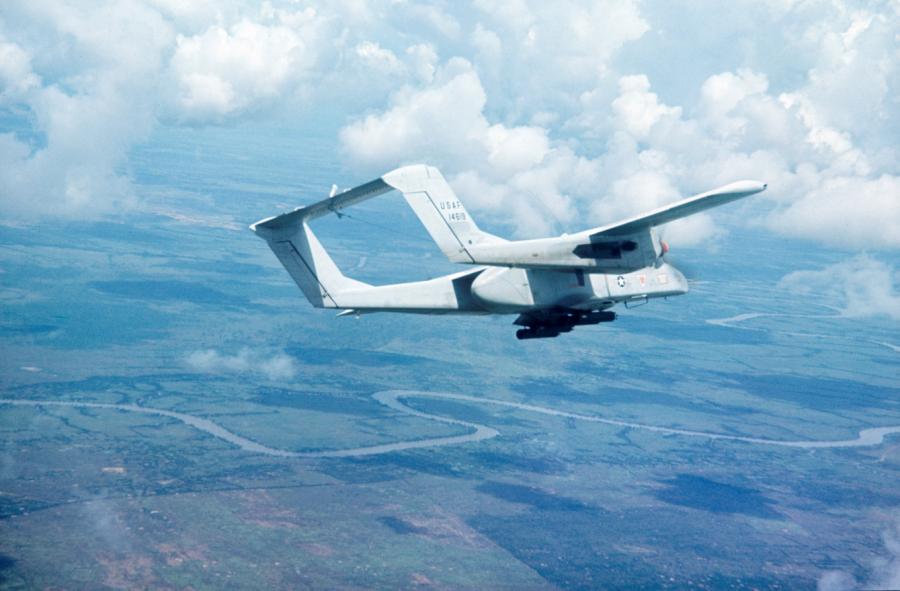
Bronco 67- 14619 over Vietnam
Bronco 67-14639 was initially assigned to the 19th Tactical Air Support Squadron (TASS), and was flown by Australians in that unit on 131 missions during the Vietnam War – including 30 strike/attack missions – for a total of 203 flying hours. The missions ranged from airstrike control in support of ground troop to artillery fire missions, escorting river convoys, visual reconnaissance, administrative flights, and participating in the rescue of downed aircrew. While the Status of Forces agreement restricted Australian and New Zealand aircrew to operations over Vietnam, USAF crews flew the aircraft extensively over Laos and Cambodia.
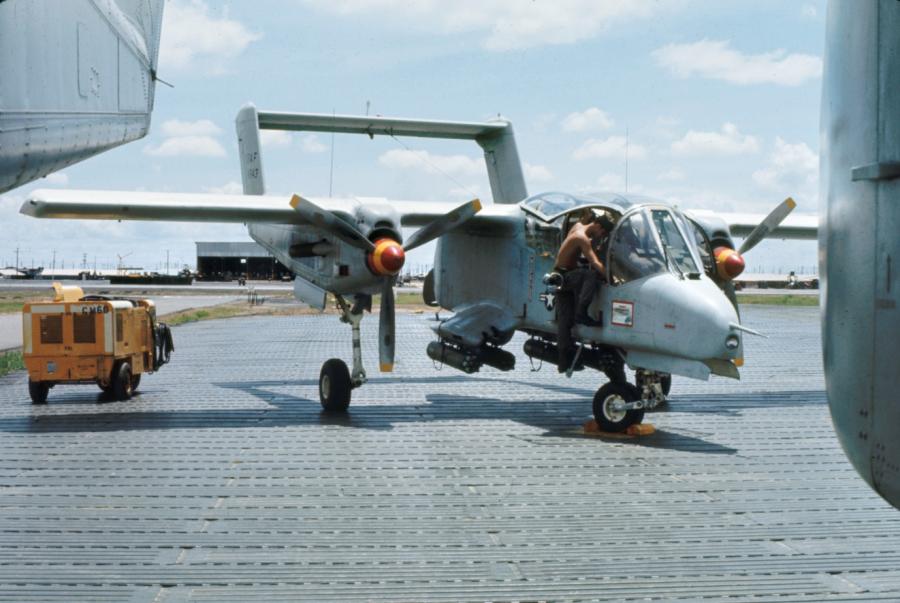
Bronco 67-14643 in Vietnam
In November 1971 the aircraft was reassigned to the 23rd TASS. A considerable part of its duties involved the interdiction of supplies on the Ho Chi Minh trail, where it directed US aircraft against convoys and supply dumps. The aircraft’s last combat sortie took place on 15 August 1973, supporting allied forces near Phnom Penh. This was the last day of active US combat in Cambodia, with a ceasefire coming into force that day. The Bronco was then flown back to Ubon Air Base in Thailand, where it remained for nearly a year.
Australian aircrew in the Bronco
Between 1968 and 1970, 13 Royal Australian Air Force OV 10A pilots were assigned to the 19th TASS, and in 1970 and 1971 seven RAAF pilots were assigned to the 20th TASS. Additionally, six RNZAF OV-10 pilots were assigned in USAF FAC squadrons: three in the 19th TASS and three in the 20th TASS.

RAAF pilots Flight Lieutenant Ron Slater and Flying Officer Peter Condon with Bronco 67-14639
The Australian and New Zealander FACs were employed according to the needs of the 504th Tactical Air Support Group. Although they wore the uniform of their countries and their administrative support and pay came from Australian and New Zealand, the USAF was responsible for their health, welfare, morale and duty assignment. The Australians worked with US personnel as air liaison officers, in the direct air support centres, and flew extensively as FACs.
At least seven of these RAAF pilots flew operations in Bronco 67-14639. A number of RNZAF pilots are also believed to have flown the aircraft. The RAAF pilots confirmed so far are:
- Squadron Leader Graham Neil (20 sorties commencing in January 1970), awarded the DFC and US DFC
- Flight Lieutenant Ronald Slater (37 sorties commencing October 1969), awarded the DFC and US DFC
- Flying Officer Peter Condon (41 sorties between July and December 1969) awarded the US DFC
- Flight Lieutenant Kenneth Semmler (18 sorties),Mentioned in Dispatches, awarded the US DFC
- Flight Lieutenant Raymond Butler (11 sorties), Mentioned in Dispatches
- Squadron Leader David Owens (2 sorties)
- Wing Commander Colin Ackland (2 sorties), awarded the DFC and US DFC.
The Memorial’s Bronco during the Cold War
In late 1974 Bronco 67-14639 was shipped to Wiesbaden Air Base in West Germany. Here it was assigned to the 20th TASS, under the command of the 601st Tactical Air Support Wing, and took part in joint air attack tactics, in which air force FACs and fighters integrated with army attack helicopters to form teams to target enemy tanks and armoured vehicles.
From 14 May 1977 to 27 August 1983 the aircraft was based at Sembach USAF Airbase in Germany, occasionally deployed to Spain to direct airstrikes on the bombing ranges near Zaragossa.
In 1984 it was flown to George Air Force Base in California to serve with the 27th TASS. The following year the aircraft was transferred to South Korea, where it flew under the 19th TASS assigned to the 51st Tactical Fighter Wing at Osan. It was returned to the United States by ship in 1988. The aircraft arrived at San Diego naval base in “plastic pajamas” to protect them from salt corrosion during their trip on the decks of naval vessels. After offloading onto barges, the Navy floated them to Naval Air station North Island, lifted them onto dry ground, and towed them to the airfield. After cursory checks by qualified functional check flight pilots and an engine run, the aircraft were flown to George Air Force Base. Maintenance staff there completed a full phase inspection before release for ferry flights to serve with the 20th TASS at Shaw Air Force Base in South Carolina.
At Shaw AFB, one of the pilots who had flown 639 in South East Asia, Greg Freix, was now Deputy Commander for Operations for the 507th Tactical Air Support Wing. With two flying squadrons among the Wing’s subordinate units, the colonels flew with both squadrons, but each chose to be attached formally to one. Initially, Greg flew with the 20th TASS, so, on the arrival of 639, he managed to assign the aircraft to the 20th TASS/20th Aircraft Maintenance Unit (AMU). However, after a year or so the commanders of the 20th and 21st TASS decided to “flip” units, for exposure to both units. Greg therefore donned the 21 TASS patch and flew with that unit until he departed. As a courtesy move, the 20th and 21st AMUs also swapped airplanes, with 639 moving to the 21st AMU. It was with the “blue tail”/Raven markings of the 21st TASS, under the flight controls of Greg Freix, that Bronco 639 flew its final USAF flight in July 1991.
The Bronco’s last days of operational flying
By 1991 the United States Government had conceived plans to remove the OV 10A from the US inventory. A small number was sent to the US Marine Corps, and a few more to the Bureau of Land Management for forest fire spotting. The remaining aircraft, from two squadrons, the 20th and 21st TASSs, were sent equally to the Colombian AF and the Philippine AF. In October 1991, Bronco 67-14639 was transferred to the Philippines Air Force under the US Government’s Military Assistance Plan. Here it received a green and grey camouflage finish. By January 1992, the aircraft was at Sangley Point Airbase in Cavite City in the Philippines, where it was attached to the 15th Strike Wing of the Philippine Air Force. Its last flight was on 13 October 1993.